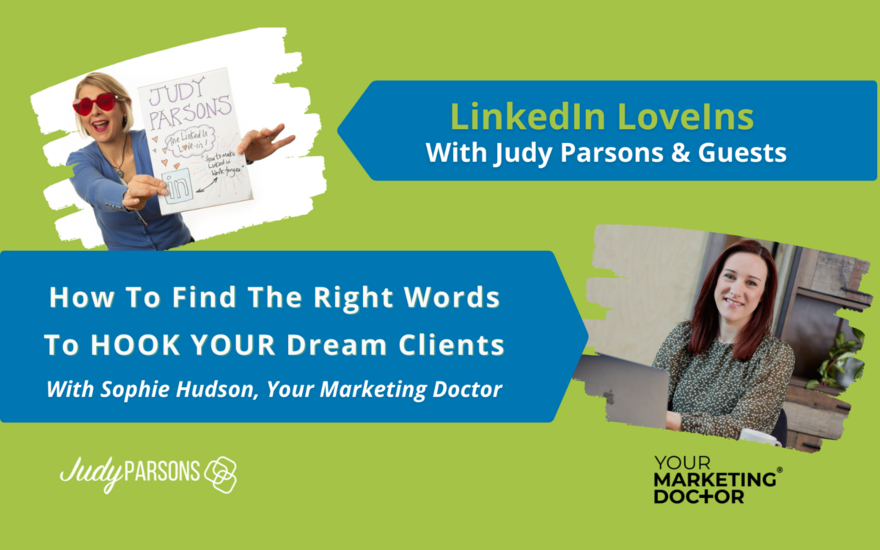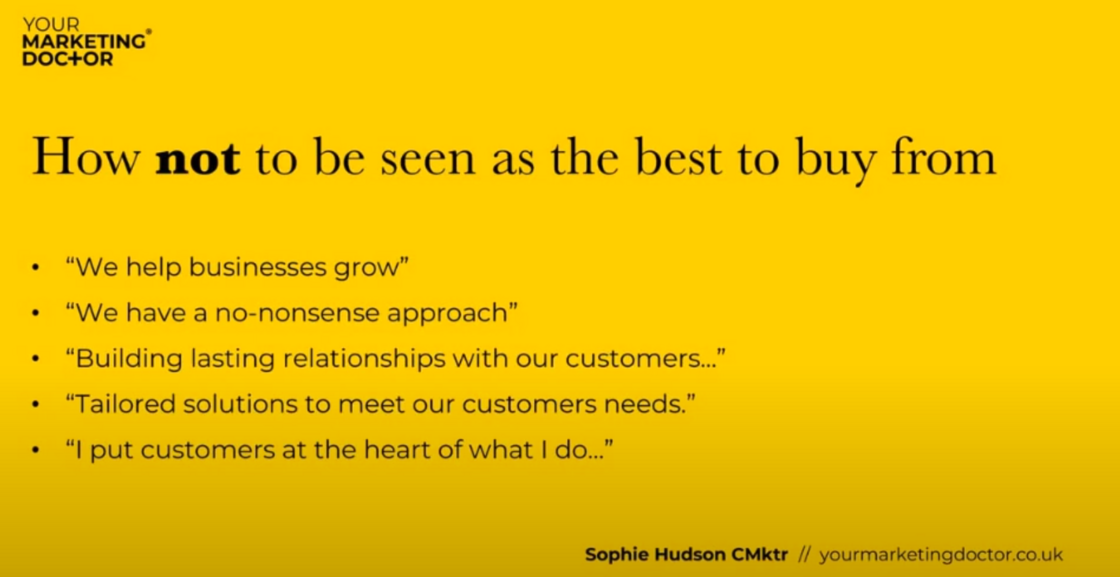How Using A Simple Storytelling Formula Can Elevate Your LinkedIn™ Content & Get You Seen As The Best To Buy From!

When it comes to marketing your business, crafting a persuasive message that speaks directly to your ideal clients is what helps you to stand out from the crowd and build meaningful relationships with your target audience.
But with a limited amount of time and space to make an impression, how do you hook your dream clients in just one line without resorting to boring cheesy clichés that anyone can say and mean nothing to your potential clients!
This is exactly what Sophie Hudson CMktr from Your Marketing Doctor and I were discussing in this month’s LinkedIn™ LoveIn where we explored how to find the right words to explain what you do and demonstrate your value so are seen as the best to buy from.
How NOT To Be Seen As The Best To Buy From
 Of course we first need to understand how NOT to be seen as the best to buy from.
Of course we first need to understand how NOT to be seen as the best to buy from.
You've probably seen these cheesy clichés many times and I know how easy it is to fall into writing these because its blooming hard to write your own stuff.
Avoid these cheesy cliches 🥱
Words can literally make or break your business. So how do you find the right words to explain what you do in a way that attracts your dream clients?
Thankfully, Sophie shared a simple storytelling framework, based on Joseph Campbell's famous storytelling formula, The Hero's Journey, that allows you to construct effective messages.
You can watch the replay of the LinkedIn Live OR to get you started, below are the four steps for creating those powerful one-liners that captures your ideal client's attention and leaves them wanting more!
;
Joseph Campbell and The Hero's Journey
Sophie started with a little history lesson for those not familiar with Joseph Campbell. A 20th century writer Joseph wrote a book call The Hero’s Journey. He was the thought leader of his time, and his book went onto influence the likes of George Lucas, who credited him as being an influence for Star Wars.
Joseph wanted to understand the process of storytelling and went onto prove that there is a pattern of narrative that you see in every single good story ever told. His theory has been used ever since by marketers in creating effective brand stories.
And we can also apply it to LinkedIn – on our profiles and posts.
The Hero's Journey Formula
Essentially The Hero's Journey includes a hero encountering a problem (our clients), going through trials and tribulations (jeopardy), finding a mentor or guide who calls them to action to avoid failure (us), and ultimately finding success (happy ending).
How To Apply The Hero's Journey Formula To LinkedIn™ and Transform Your Results!
Place your client as the hero who has a problem, and you are their guide who has a plan of action. You have the solutions to solve their problems and all they need to do is to take one simple step to avoid failure and instead achieve success.
Here are the four steps you need with Sophie's example showing how it works:
Step 1: Who Is Your Customer and What Problems Do They Have?
Think about the conversations you have with your potential clients, what do they ask you?
What do they tell you that they have a problem with? Or what is it that you can solve for them?
You then start writing your opening line which should always state the problems your customers have.
For example, “Marketing is hard when you can't find the right words to say what you do.”
That’s the opening of the story. Your customer has a problem in that they can't find the right words to say what they do.
Step 2: Expand The Jeopardy
i.e. You have this problem and if you don't solve it, it's going to get worse.
Continuing with the example above “Marketing is hard when you can't find the right words to say what you do. If you give off the wrong message, then you're probably missing out on sales.”
So “If you give off the wrong message, then you're probably missing out on sales.” That is the jeopardy. That is what will happen if you don’t solve your problem.
Step 3: Give Them A Simple Plan of Action (or Call To Action)
What's the plan that you have as your clients' guide?
What do they (your clients the hero) need to do to solve this problem?
“Marketing is hard when you can't find the right words to say what you do. If you give off the wrong message, then you're probably missing out on sales. But with my Three part Value Proposition Clinic . . . "
So the call to action in this example is Sophie's 3 part value proposition clinic.
The plan or call to action doesn't have to be a complicated. It can be something as simple as filling in a form or booking a demo or picking up the phone. It’s basically the first step of the plan your clients need to take to solve their problem.
Step 4: The Happy Ending
By now your clients are on the edge of their seat and wanting to know what's going to happen:
"Marketing is hard when you can't find the right words to say what you do. If you give off the wrong message, then you're probably missing out on sales. But with my Three part Value Proposition Clinic, you'll learn how to stand out from competitors and be seen as the best to buy from."
So the happy ending or what they are going to get from is to learn how to do it right.
Where To Use This On LinkedIn™ . . .
The whole idea of using this simple framework is that you want your clients to ask questions in order to start a conversation.
Which is exactly what we want to use LinkedIn for.
On LinkedIn we are looking to open the door to conversations and take those conversations off LinkedIn and into either a face to face or Zoom chat or on to your mailing list for example.
Using this formula is perfect for your About section on LinkedIn. Especially in those first few lines before someone has to click on "See more" to create that curiosity to learn more and hook your dream clients in to asking you questions.
And use it on your posts as well. When writing posts we need a 'hook' to stop the scroll and the opening line of your story (so your clients' problems) is a great hook to use.
Regardless of whatever marketing we do, whether its on LinkedIn or at a networking event we should always have our ideal client and their problems front and centre.
And be really clear on the challenges we help our clients solve and as their guide have a simple plan they can follow to solve their problems, prevent the jeopardy from happening and give them a wonderful happy ending.
Let me know. Will this framework help you craft the words to hook your dream clients?
Join the LinkedIn™ LoveIn group

Join the LinkedIn LoveIn Group and keep up to date with the latest LinkedIn tips and tricks!
💙 If LinkedIn isn’t working hard for you or you’re not sure where to start with using LinkedIn, email judy@judithparsons.com or connect with me on LinkedIn to chat about how I can help.
Or book a virtual brew here and let’s make #LinkedIn work for you . . . ⭐

